what are the best mechanical pencils
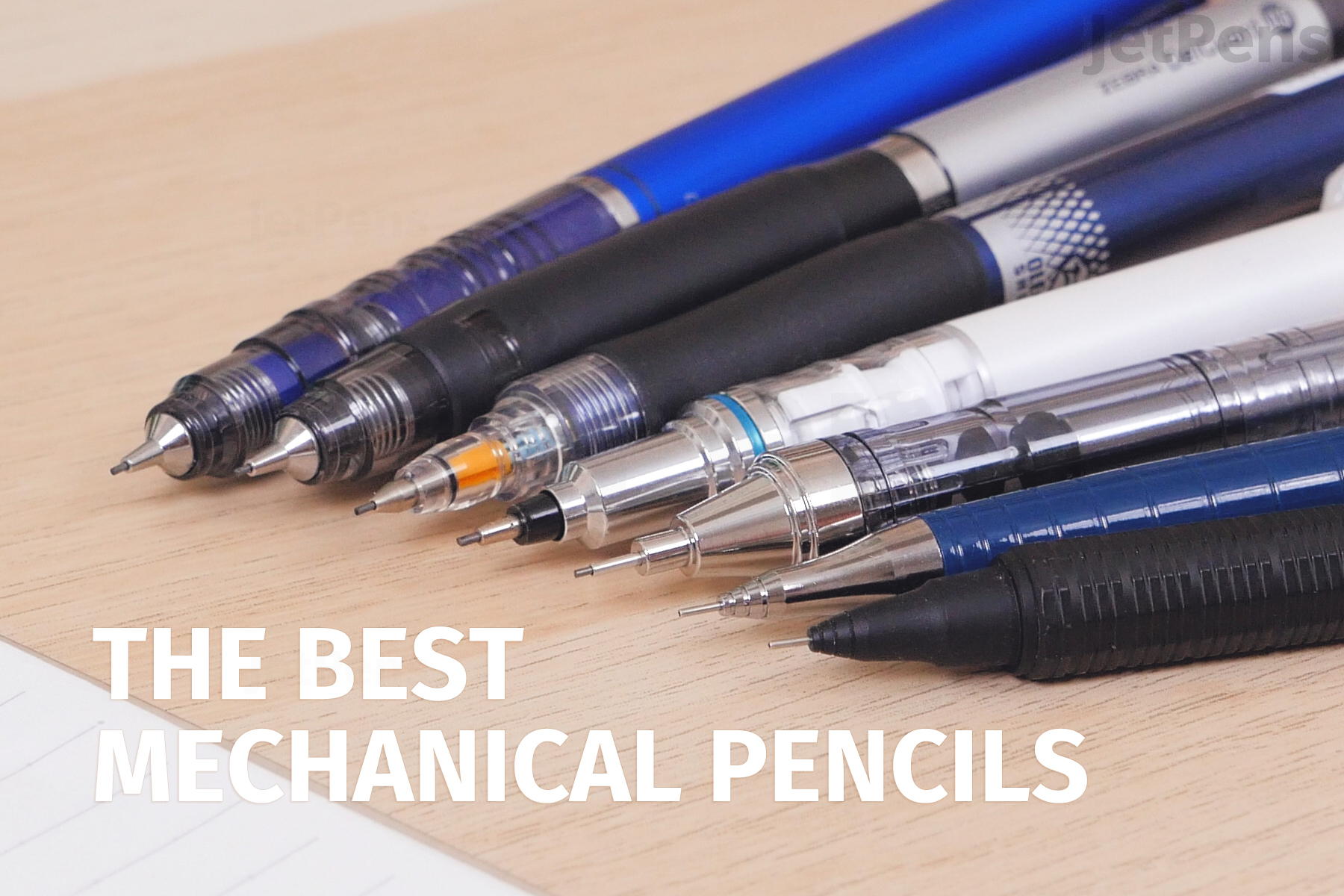
Do you need some pointers on picking out the perfect mechanical pencil? With so many to choose from, it can be hard to know where to start looking. In this guide, we'll share our top mechanical pencil recommendations, along with some tips on how to choose the one that's right for you.
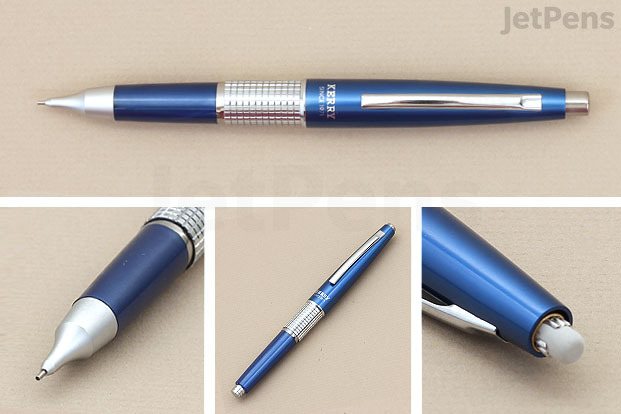
Combining the looks of a high-end executive pencil with a very reasonable mid-range price, the Pentel Sharp Kerry is easy to fall in love with. With its distinctive capped design and attractive resin barrel, it resembles a fancy rollerball or fountain pen. Its cap isn't just stylish—it keeps the tip from bending, as well as protecting your pencil case or pocket from poking. When capped, the Kerry is an easily pocketable 4.9" long, and with the cap posted it is a well-sized and perfectly balanced 5.2". A cleverly integrated button in the cap lets you extend the lead whether the cap is posted or unposted. Removing the cap button reveals an eraser, and removing the button on the body of the pencil exposes the lead storage tube. The Pentel Sharp Kerry is a sleek, smartly-designed pencil for any occasion.
Mechanical Pencil Recommendations
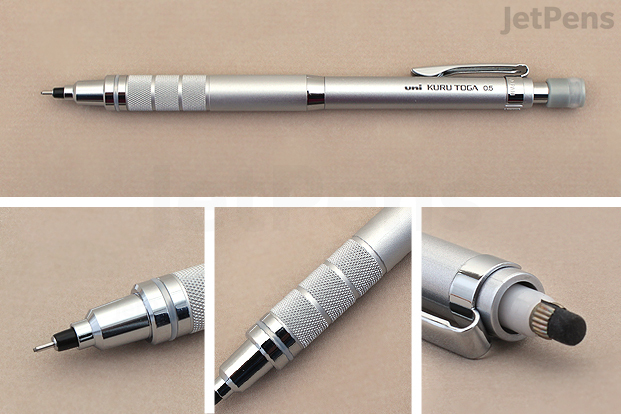
When Uni introduced the Kuru Toga, it was a revolution—literally. With a conventional mechanical pencil, the tip of the lead gets worn down into a broad wedge shape as you write, making your writing look uneven. The Kuru Toga solves this problem with its built-in ratchet mechanism that rotates the lead slightly every time you lift the lead off the page. This causes the lead to be worn down into a sharp, consistent conical point.
The Kuru Toga is aptly named by taking two words from the Japanese language and merging them together. "Kuru" (クル) is an onomatopoeia for something turning or rotating, and "toga" (トガ) is taken from the verb "togaru" (とがる), meaning to taper to a point or become sharp. The name conjures up an image of something constantly spinning to a precise point, which is exactly what the Kuru Toga does.
The Kuru Toga Roulette takes this auto lead rotation mechanism and puts it into a luxuriously sleek, high-quality body. It features a metal grip section that's comfortable to hold and gives the Roulette a low center of gravity—a characteristic that makes the pencil feel more nimble and easy to control in the hand. Three rows of gentle knurling on the grip provide extra purchase for your fingers as well as added visual appeal.
There are only two things that kept the Roulette from sharing the top spot with the Pentel Sharp Kerry. First, the fixed lead sleeve makes it less portable and pocket-friendly than it would be if it had a retractable lead sleeve. Second, the Kuru Toga mechanism can cause a slightly squishy feeling when you press the lead down on the paper and the tip retracts a fraction of a millimeter. It's a very minor sensation and we stopped noticing it almost immediately. But if you are especially sensitive to pencils with a little give in the tip, the Kuru Toga may not be the best choice for you.
To learn more about the Kuru Toga mechanism and all the different pencils it comes in, be sure to check out our comprehensive guide.
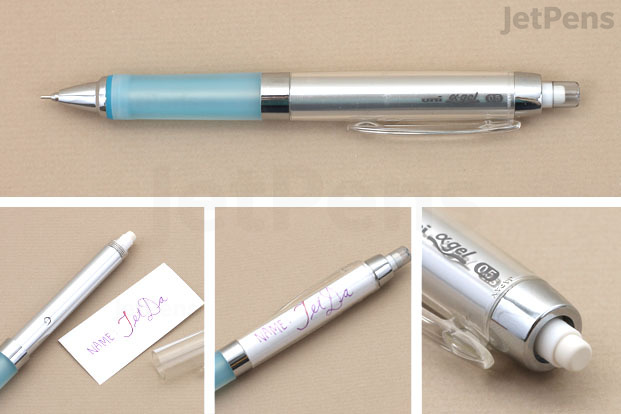
For the ultimate ergonomic mechanical pencil, the Alpha Gel Kuru Toga wins hands down. Not only does the delightfully squishy silicone Alpha Gel grip mold luxuriously to your fingers, the Kuru Toga mechanism keeps the lead sharp and consistent. You can even watch the mechanism spin through a small window in the barrel of the pencil.
And, although this is not advertised anywhere on its packaging, we found that you can even customize the look of the pencil by unscrewing the clear plastic outer barrel and inserting a rolled piece of paper decorated however you want!
Available in 0.3 mm and even 0.2 mm lead sizes, the Pentel Orenz is the final word when it comes to ultra-fine writing and drawing. Normally, these lead sizes are prohibitively delicate for all but the lightest-handed users. But thanks to the Orenz's long sliding lead sleeve, which protects the entire length of the lead, broken leads are virtually a non-issue. As you write with the Orenz, the lead sleeve gently touches the paper and retreats back into the tip of the pencil as the lead is worn down. The edge of the lead sleeve is rounded, so it doesn't feel like it's scratching or catching on the paper as you write.
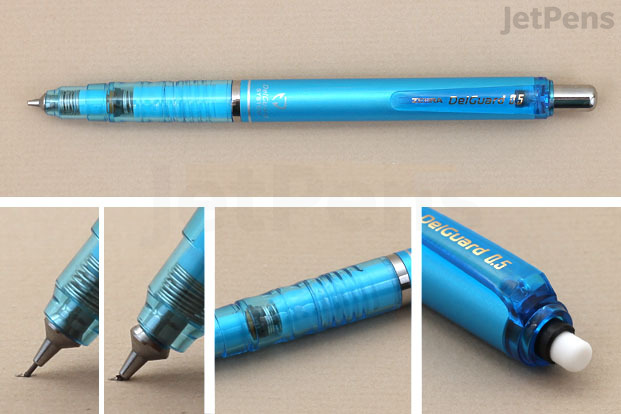
The Zebra DelGuard uses an ingeniously engineered two-part system to protect lead from both vertical and sideways pressure. A spring in the barrel allows the lead to retreat into the pencil tip if it faces too much top-down force. A second spring in the tip of the pencil extends a pipe when it senses too much lateral stress. These combined mechanisms create a pencil that effectively protects its lead no matter how it's held.
If you're interested in lead guard mechanical pencils, be sure to check out our guide!
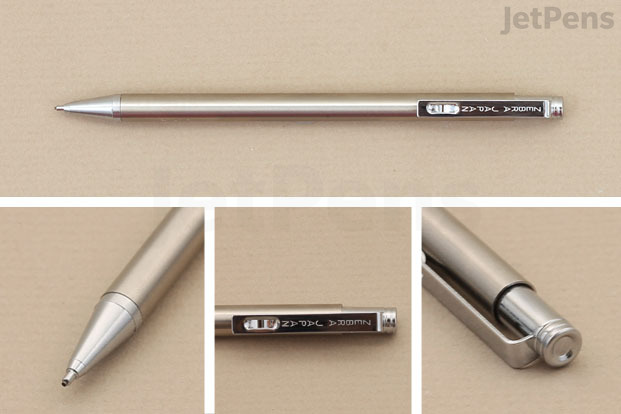
For the absolute smallest mechanical pencil around, we recommend the Zebra Techo TS-3. At under 4 inches in length and just 5.5 mm in diameter, it will slide inconspicuously into the smallest pants pocket or planner pen loop. It's great for jotting down a quick note, but its short length and slender profile can make it a bit uncomfortable for those with larger hands. If you want something just a little bit bigger, the Platinum Mini Mechanical Pencil is another great choice.
No one mechanical pencil will perfectly suit all artists, but we've picked the Pilot Color Eno because a wide range of artists should find it a fun addition to their process. Its soft colored lead creates vivid sketches that don't show through under ink and beautifully complement watercolor washes, and it erases with ease. Some colors, like soft blue, can also be digitally removed from scanned ink lines.
Color-coded pencil bodies make it effortless to pick the right Color Eno from your pencil case. Refill these pencils with colorful Pilot Color Eno Neox leads (or even put it in any 0.7 mm pencil you choose). One warning: the leads are not lightfast, so they're best for temporary applications like underdrawings or sketchbooks that you keep out of the sun.
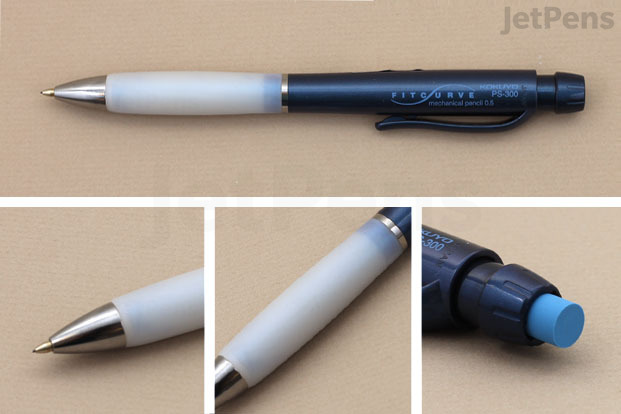
The Kokuyo FitCurve is one of our all-time favorite mechanical pencils and a perfect choice for students. Its wide, firm rubber grip will keep hands comfortable during marathon note-taking sessions, and its replaceable, inch-long twist eraser ensures that you'll always be ready to correct an errant mark or math equation. A sliding lead sleeve helps protect the lead from breaking and lets you write longer between clicks of the top push button.
The Kaweco Special features the elegant mix of modern and classic styling that distinguishes Kaweco writing instruments. Its octagonal body and long nose cone evoke the image of a traditional wooden pencil. The edges of the body are gently rounded to provide a surprisingly comfortable writing experience.
The Special is available in two materials: sleek, lightweight aluminum and hefty, eye-catching brass.
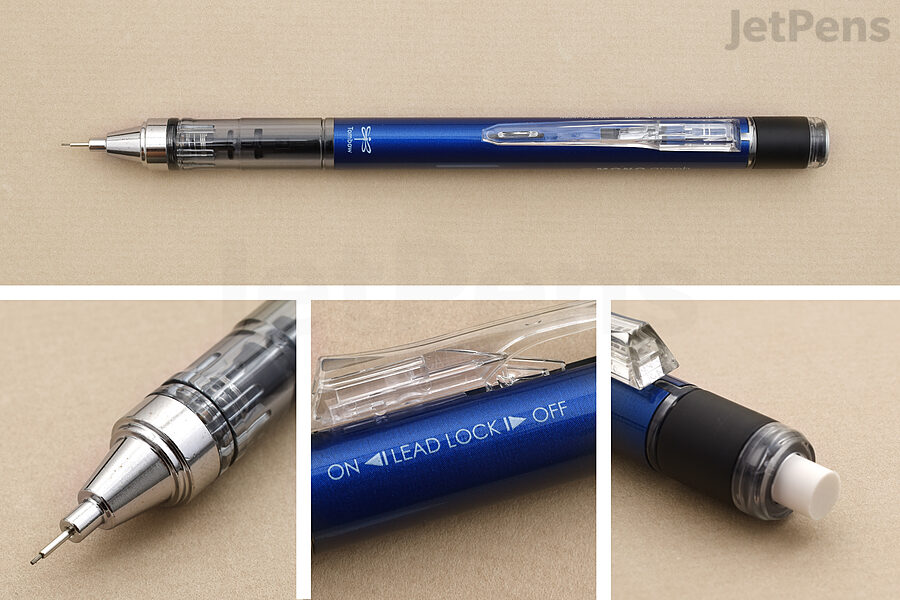
The Tombow Mono Graph Shaker Mechanical Pencil is a classic and effective shaker pencil. Its shake-extend mechanism is the quietest we carry, gently releasing more lead with minimal rattle or bounce. Plus, it includes a locking mechanism, so your lead won't escape and break off in transit. Lead can also be extended (or retracted) by pressing down the side clip. The Graph Shaker caps everything off with a generous twist-extend eraser, and as a final bonus, it's available in more colors than the rainbow, including pastels, neons and metallics.
Mechanical Pencil Considerations
Lead Advancement Mechanism
Mechanical pencils can use a variety of different methods to advance the lead. This is something you'll have to do a lot when using a mechanical pencil, so it's worth considering which kind of mechanism you prefer.
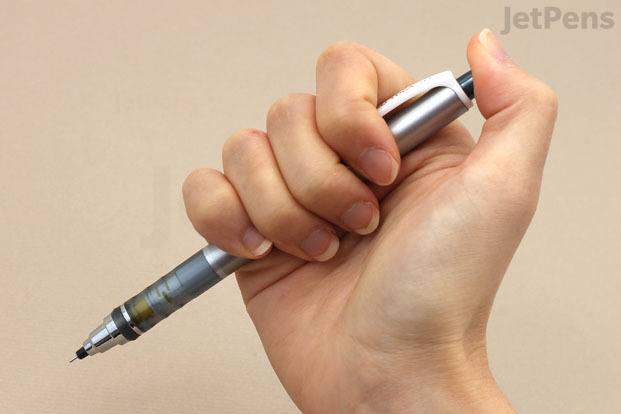
Push button lead extension is the most common option.
The vast majority of modern mechanical pencils use a push button that advances a fixed amount of lead with each click. The button is usually on the top of the pencil, but it can also be on the side of the pencil or even built into its clip.
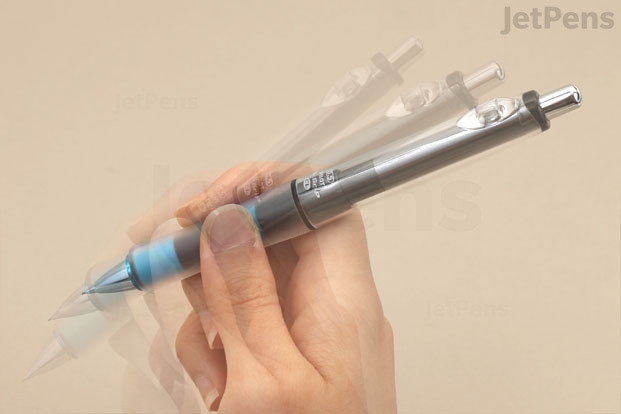
Shaker lead extension means that you don't need to change your grip.
The shaker mechanism is a relatively recent addition to the mechanical pencil world, but it has caught on in a big way. With a shake of the pencil, a sliding internal weight activates an internal click mechanism to advance the lead. This lets you advance the lead without having to change your grip. Many people find shaker pencils to be easier or more comfortable than push button pencils, but not everyone does. Conveniently, virtually all shaker pencils also include a conventional push button mechanism as well.
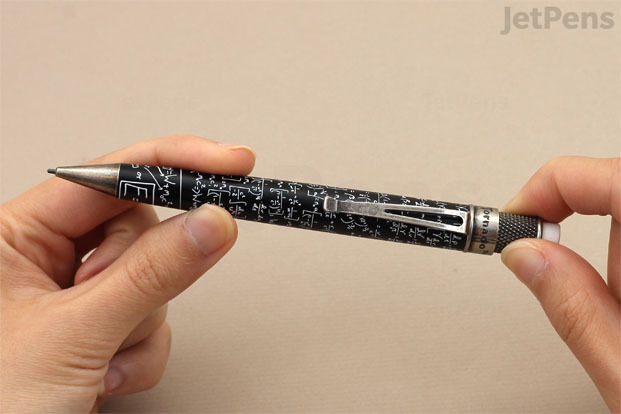
Twist extension mechanisms allow continuous adjustment.
Twist mechanisms advance and retract the lead with a turn of a knob located in the top cap or nose cone of the pencil. This allows continuous adjustment of the lead, letting you choose the exact length of lead that you want. Twist mechanisms are particularly common among older mechanical pencils. Twist mechanisms do have some limitations, however. They are usually only found in pencils that take wider leads (0.7 mm and above) and generally only hold one piece of lead at a time.
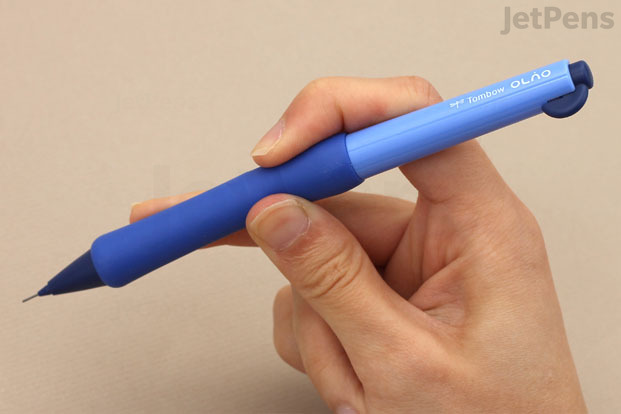
Bending is an unique lead extension mechanism.
This innovative mechanism allows you to advance the lead simply by squeezing the pencil at a special joint in the grip section. In practice, the mechanism works like a side push button, but because the pencil can be bent in any direction it doesn't need to be held in any specific way.
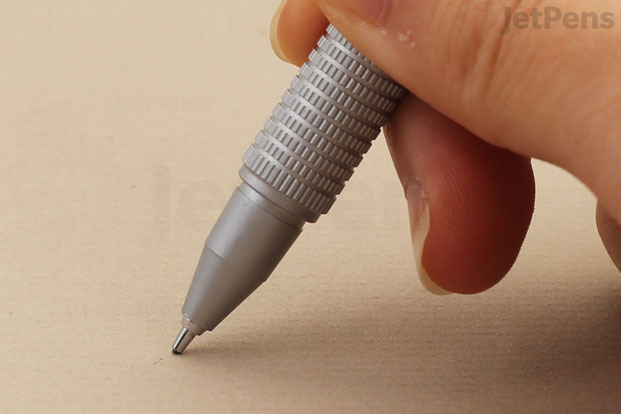
Automatic lead extension is convenient but may take some getting used to.
With an automatic mechanical pencil, you don't need to do anything to advance the lead! Just keep writing, and once the lead is used down to the edge of the lead sleeve, the pressure of the paper on the lead sleeve activates a ratchet mechanism that pushes out more lead. In practice, this means that you will be doing most of your writing with the lead sleeve dragging on the paper. Some people find this bothersome, so keep it in mind when considering an automatic pencil.
Lead Size

Find the right lead size to suit your writing style.
Lead size is one of the most important parts of how a mechanical pencil writes. Thinner leads produce sharp, fine lines but are more fragile and easily broken. Wider leads are smooth and break-resistant, but they are not the best for fine detail work. Most mechanical pencils use 0.5 mm or 0.7 mm leads, which offer a great balance of precision and break-resistance, but some use leads as fine as 0.2 mm or as broad as 1.3 mm. 0.5 mm and 0.7 mm pencils also have the widest selection of lead grades to choose from.
| Lead Size | Recommended Uses |
|---|---|
| 0.2 mm to 0.4 mm | Extra-fine writing, detailed drawings, compact math equations |
| 0.5 mm | Everyday writing and drawing, math equations, applications that call for a variety of lead grades |
| 0.7 mm | Everyday writing and drawing, heavy-handed writers, applications that call for a variety of lead grades. |
| 0.9 mm and up | Bold writing and sketching, very heavy-handed writers |
Grip Section
A comfortable grip section is essential to a good writing experience. Mechanical pencil grips come in a range of diameters and materials, and your individual preferences will determine what kind of grip will work best for you.
Diameter
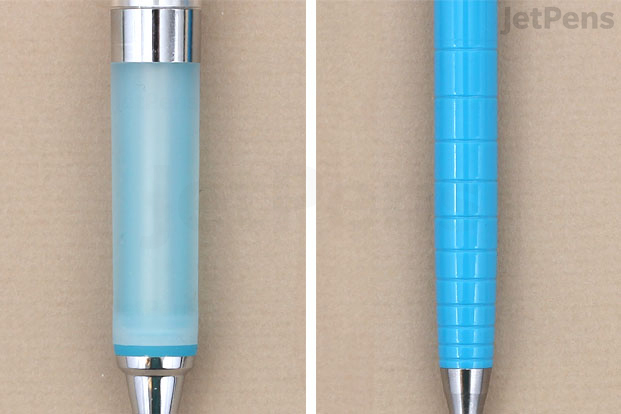
Wider pencils are easier to hold for long writing sessions, but narrow pencils are better for smaller hands.
Mechanical pencil grips can vary widely in diameter. A wider grip may be best for those with larger hands or those suffering from arthritis, repetitive strain injury, or other hand issues. People with smaller hands often find a narrower grip to be more comfortable.
Material
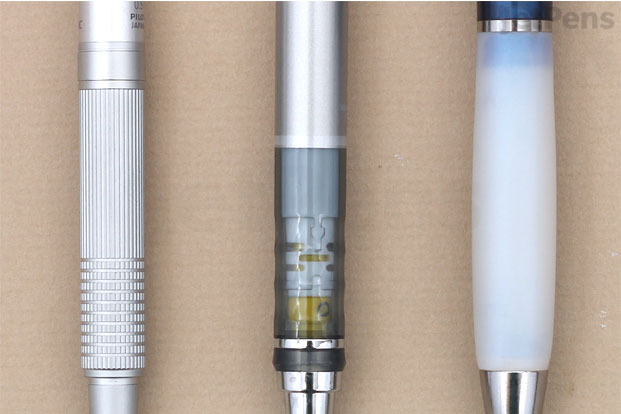
Material determines grip texture.
Mechanical pencil grips also vary in material. The most common materials are plastic, rubber, silicone, and metal, but more exotic materials are also available. Plastic grips are firm and warm quickly to the touch. Rubber and silicone grips can range from firm-yet-grippy to pillow-like squishiness. Metal grips are firm like plastic, but they have a much weightier feel and can remain cool to the touch for longer than plastic.
Eraser
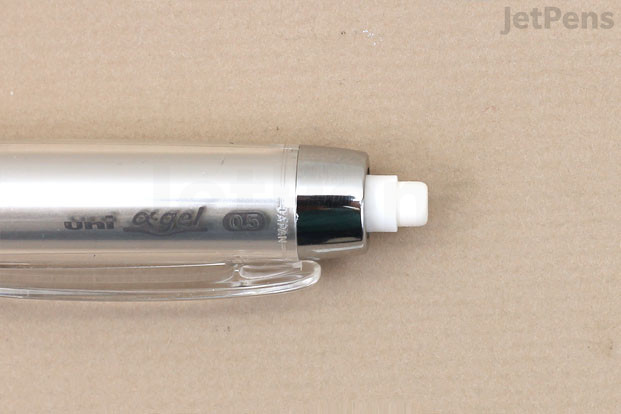
An eraser might make or break your mechanical pencil experience.
Most mechanical pencils include a built-in eraser, but it's often quite small. For those who plan to regularly use their mechanical pencil's eraser, we recommend choosing one with a generously sized, replaceable eraser—like the Kokuyo FitCurve or Pentel Twist-Erase III.
Advanced Features
Even after hundreds of years1, mechanical pencil designers continue to develop innovative new features to make them even better. Here are some useful ones to be aware of.
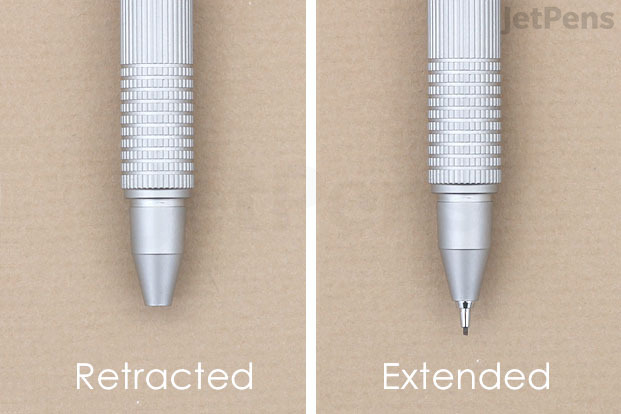
Pockets and pencil cases everywhere cheer the invention of the retractable tip.
Mechanical pencils with long metal lead sleeves can pose a particular threat to pockets and pencil cases, poking holes and scratching other pens and pencils. They can also get bent jostling around, rendering the pencil useless. Because of this, many mechanical pencils feature retractable, "pocket-safe" tips.
Retractable tips come in a variety of styles, but the most common type works by holding down the pencil's top push button, pressing your finger against the end of the lead sleeve, then releasing the push button. The lead sleeve will slide back into the tip of the pencil until the next time you press the top button.
Lead Protection
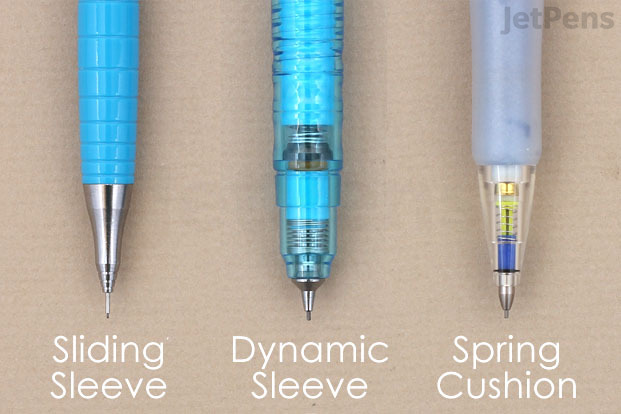
Designers have found plenty of ways to keep lead safe and sound.
Broken leads are annoying, so mechanical pencil designers have come up with several ways for pencils to protect leads and prevent breakage.
The most common form of lead protection is a sliding lead sleeve. Lead sleeves do a great job of bracing pencil leads against breaking, but they can only protect the lead they actually cover. With a sliding lead sleeve, the surface of the paper pushes the lead sleeve back into the tip of the pencil as the lead wears down, letting you keep on writing with all but the very tip of the lead always protected.
Some mechanical pencils offer more advanced lead protection:
- The Pilot Mogulair and Platinum OLEeNU have a built-in spring that cushions the tip of the pencil to absorb excess writing pressure. If you prefer a more industrial look, the Rotring Rapid Pro drafting pencil also has this feature.
- The Zebra DelGuard has a similar spring cushion as well as a specially designed lead sleeve that dynamically extends to protect the lead when too much sideways pressure is put on it.
Dual Clutch
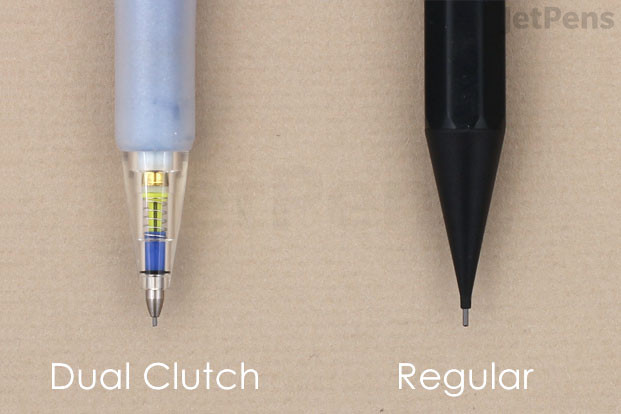
Dual clutch mechanisms cut down on wasted lead.
Dual clutch mechanical pencils like the Platinum OLEeNU feature a special tip design that lets you use leads up to the last millimeter. Most mechanical pencils hold the leads in a clutch mechanism located about a centimeter back from the tip of the pencil. Once the lead is too short to reach from the clutch to the tip, it falls out. Not only is this annoying, it wastes over 15% of a typical lead.
With a dual clutch mechanical pencil, as long as there is a second lead in the pencil for the main clutch to hold in place and extend, you will be able to use virtually the entire length of every lead.
Auto Lead Rotation
A feature currently unique to the Uni Kuru Toga line, auto lead rotation keeps the lead sharper and more consistent. With other mechanical pencils, the lead wears down over time from a sharp point to a broad chisel shape. By using a ratchet mechanism that rotates the lead slightly every time it is pressed against the paper, the lead is evenly worn on all sides, creating a conical lead shape that provides sharp, consistent writing.
One potential downside to the Kuru Toga mechanism is that it creates a tiny feeling of squishiness at the moment when the lead first touches the paper. We found that we quickly adjusted to this effect and stopped noticing it before long, but if you need a mechanical pencil with a perfectly rigid tip, the Kuru Toga might not be for you.
For more information on Kuru Toga pencils and the auto lead rotation mechanism, check out our guide.
Our writers draw on their personal expertise, consult our in-house subject matter experts, and do extensive research to make our guides as accurate and comprehensive as possible. We then test every finding that makes it through the research stage. Only the techniques and tools whose performance we personally confirm make it into our guides as recommendations.
Final Thoughts
With so many types and styles of mechanical pencils choose from, there's one to suit anyone's tastes. Do you have a favorite mechanical pencil? We'd love to hear about it in the comments below!
what are the best mechanical pencils
Source: https://www.jetpens.com/blog/The-Best-Mechanical-Pencils/pt/809
Posted by: hernandezmakentance.blogspot.com

0 Response to "what are the best mechanical pencils"
Post a Comment